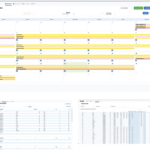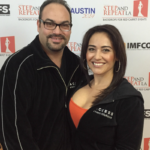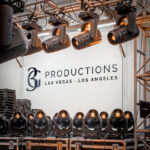Competition between vendors in any business is commonplace. But the entertainment business has long been known as a cutthroat place where saving dimes can amount to earning thousands of dollars in the long run. So many companies make similar products that a buyer can easily shop around for the best deal. Companies spend serious cash on R&D for a new product, only to find other companies copying their ideas a year later. The business of metalworking — especially truss manufacturing — is no different.
The truss business is more competitive than ever, and the only way to keep at the top is to be efficient and try and cut some of the competition down. Area Four Industries was created in 2015 with just that in mind. Tomcat, James Thomas Engineering, Litec and Milos are all huge truss manufacturing entities by themselves and will remain separate companies with separate websites. But they have come together in a quest for each to continue to evolve with new products, but not compete with each other over similar items.
A brief history is in order. Milos was founded in 1994 in the Czech Republic where they still maintain their offices today. They expanded over the years with new facilities in other countries, most notably the one in Guangzhou, China. Tomcat is an American company that has been around since 1987. They grew to become a global presence. In 2012, they started working with Milos under The Milos Group name. James Thomas Engineering originated in the U.K. in 1977. For years they and Tomcat offered many similar products, but were separated by an ocean and two distinctively different sets of clients. In 2014 Tomcat and James Thomas combined forces at the Tomcat facility in Knoxville, TN. Many of their products are fabricated in Knoxville now, but much of their metric items are also made in Italy for their continued service in the European market. Lastly, the Italy based company, Litec, has been a major player in the aluminum structure business since it was founded in 1991. In 2012, these four companies joined forces to better serve their clients as the largest aluminum trussing and staging manufacturing group in the world.
What’s in a Name?
I’m sitting down with the leaders from Area Four Industries. Scott Johnson is president of Tomcat and James Thomas Engineering; Frank Zykan is the director of Milos; and Fabio Prada is the managing director of Litec and James Thomas EMEA (Europe, Middle East and Africa). They are eager to explain to our readers why they all fall under one group, yet plan on maintaining their separate identities.
“There was a specific way the Area Four concept and name came about,” explains Prada. “The word ‘Area’ stands for a place where ideas of all kinds can be floated about. An area where you can collect all kinds of input from all kinds of markets across the world. Area stands above our individual brands with its mission to join each company’s heritage, history and knowledgeable experience to design and build anything necessary to fill your truss and staging needs.”
“The word ‘Four’ stands for the four different brands of truss. We have four different DNAs, four different personalities, four different locations in the world.”
With current locations in the U.S., Italy, the Czech Republic and China, the globe is well covered by group. The “Four” also stands for the main markets they cover: Entertainment, exhibition, architectural and custom projects. There are also four different ways in which these companies connect their truss models — conical, fork, cam-plated and base plated.
“We chose to call ourselves Industries as opposed to a ‘group,’” says Prada. “It seems everyone has a group these days. We are truss manufacturers, metal workers. It sounds industrial. It inspires vision. Hence our logo is a square with a single line exiting the bottom. This symbolizes four brands coming together to serve as one.” This industry now employs close to 400 people worldwide.
There is a proper plan behind Area Four. Unlike the scenario where a wealthy person wakes up one day and decides to use his money to pick up some companies and get bigger, that is something that never crossed their minds. Instead, they had a plan to do something completely different than what anyone else was doing in the business. They wanted to stop competing with each other, yet be able to cover any needs any client has with one huge inventory of products. Prada expands on this: “What we want to put together is the experience from all the different parts of the world and elevate the truss business to a completely different level from what anyone has experienced until now.”
This includes the first real properly organized rigging team that is going to put together all kinds of ideas, summed up in a key company slogan: “You know what, we know how,” Prada says. “We want people to come to us with an idea, but without being clear on what they need. Our know-how can turn their vision into reality. This person may know the best way to achieve a solution in America, but will it work in the European market as well? We have the team that can answer all those questions.”
Getting Technical
One of the first things that crossed my mind when I thought of these four brands coming together was “Don’t these guys all make the same stuff? If I want to buy 20.5-inch truss which company do I go to?” Well, the answer is yes and no. Of course they all offered 20-inch box truss before they got together, but each company offers a different option in lengths but more importantly, how they connect together.
I asked Tomcat’s Johnson how they deal with this scenario. “Believe it or not, we don’t all offer the same truss. One of the reasons Area Four came together was to be able to offer our customers all the options. If a vendor already has a huge assortment of one model of truss, they may prefer to keep their inventory the same. They may want something Tomcat doesn’t offer, and that’s when I hand them off to another member of our team that can facilitate their needs. While we do all offer a 20-inch model of box truss, we all offer different ways in which we connect them.” In this writer’s experience, I have used a lot of truss with conical connectors overseas, but have noticed more trusses use base plates or fork connectors in the U.S.
“We have combined James Thomas Engineering and Tomcat’s products into one large catalog,” Johnson continues. “We still manufacture most of the gear. Some things we have abandoned, because there is no use for two very similar models, like truss spot chairs for instance. We don’t list two different models anywhere.”
“But, of course, if a customer demands the same spot chair, we will accommodate them,” Zykan is quick to add. “The customer made a choice when he picked out that first chair or piece of truss. We must respect their decision as they chose us in the first place when they could have gone elsewhere for their needs.”
If one company already manufactures a well-designed product, there is no need for another one to build a separate model. For instance, the Europeans build a lot of metal barricade already, so Tomcat has it in the Area Four inventory and does not have a need to design their own model.
But suppose you own a great deal of Thomas pre-rigged truss, which differs slightly from the Tomcat version. “We will make that version for you,” Johnson says. “You want the old non-polished aluminum look that the Thomas truss had; we can supply that at no extra cost.” Johnson also points out that, if you want to buy something in America that is made in Europe, it is no problem. They will give you a set price out of their Knoxville office and deliver it to you on time. You do not have to deal with tariffs and any other unforeseen shipping charges.
Moving Forward
The spread of the marketplace is huge, and Area Four Industries is able to cover virtually everything, product-wise. “At one end of the spectrum, we have the smaller mobile DJ setups that cater to the local DJ or small club band,” notes Milos’ Zykan. “At the other end, we have the special needs groups, like the U2 structure that toured a couple of years ago, which can be huge projects to engineer and construct.
“Geographically, things vary in the truss world,” Zykan adds. “Something we designed may not be selling well in Europe, but there is a huge demand for it in the U.S. marketplace. In that case, we will have Tomcat start making the product at their facility instead of ours. But every brand is still preserving their identity.”
“Perhaps the best way to explain how we all coexist is to make a comparison,” Zykan adds. “In America you have the Chrysler group. This group includes Fiat, Chrysler and Maserati, etc. All these cars can go under 50 mph, but only a few can go 200 mph. So basically, you have different products to meet different demands. One wouldn’t expect Fiat to make a model to compete with Ferrari.”
Area Four Industries states they don’t want complete globalization where everything is built in one location, like China for instance. “So we act globally, but we think locally. We respect and support our customers, but in a different way from any stand alone company. By unifying we enjoy certain economical perks.” Zykan continues. “We get better prices on aluminum. If we agree that a common screw could be utilized by all of us we buy them in bulk to keep the costs down. Prada agrees, “Efficiency is the key to being successful in the truss business. But you also need to be able to custom modify a piece. Flexibility is king.” Johnson adds “We are fortunate to have the manufacturing facilities in this group and around the world but Tomcat and James Thomas US will continue to be serviced out of the Knoxville facility with U.S. and some European made product for Tomcat. However, the complete James Thomas US product will continue to be made completely in our U.S. facility.”
None of these companies is remaining stagnant. They realize that they have to keep raising the bar with new products, coming up with new game changing ideas. For instance, James Thomas Engineering was integral in the design of the BAT truss utilized by PRG and others. This truss was designed by Johnson (while at JTE) along with Scott Gross from PRG.
This January Tomcat has gone into full production mode, building their revolutionary truss (also an idea from Johnson). This is a collapsible 12-inch box truss that will save users huge amounts of truck and warehouse space. 45 ten-foot sections can be stored in the same area as 18 regular truss sections of the same dimensions. Tomcat specializes mostly in all types and sizes of trussing. Every year they hold Tomcat U, a rigging workshop for anyone wanting to learn about motors, truss and rigging.
Litec has been showing off some really high-load truss with their line of MyT truss. The line of Libera truss has been heralded as a game-changer in the ways one can assemble different roof structures in various shapes and sizes. One of the most amazing engineering feats I have witnessed lately is the Libera Alusfera dome-shaped roof system (see photo, previous page). They also offer a wide range of ground support lifts and have now ventured into rigging supplies, most notably the release of their incredibly smart motor system featuring the EXE RISE chain hoist models.
Milos produces a wide range of products and structural solutions that can adapt to required conditions. They cover the gamut in trussing, from lightweight truss designed for tent use to heavy-duty truss with all sizes in between. They also make great crowd barriers, rigging towers and portable stage decks of all kinds. They boast of an unequaled compatibility with connection systems from most other truss manufacturers as well.
James Thomas Engineering manufactures all kinds of truss from general sizes to Supertruss to moving light truss. They build ground support towers that tie in with their roof systems. They have catwalk systems that can be used in conjunction with their Supertruss. They also offer rigging supplies from spansets and shackles to lifting points for various sized trussing.
Keeping Up with the Orders
The past year was a banner one for Area Four Industries, and I ask the guys how they keep up with the demands of their clients. Prada explains a typical scenario. “Nowadays, what happens is, the customer will sign a contract for a project, then two weeks later they want the goods. They may have negotiated with us for three months prior to giving the go-ahead on the deal. Of course, that’s not a great scenario, but we have to come through for them, because the client sets the rules. The pressure to come through is unbelievable in comparison with other markets.”
Even so, Johnson notes that “we can turn our custom projects around very quickly at Tomcat. We keep over a thousand pieces of our general truss in stock so we can readily fill orders and ship them the same day. We have 60 employees with over 20 full time welders. We have welding lines for Tomcat products, separate welding lines for James Thomas items and another division of employees that just work on the custom projects that come in.”
Wrapping up, Zykan notes that “we each have a specific range of products we make. By combining these companies, Area Four Industries covers everything you need structurally for your event. We are here to listen to what you need and if it doesn’t exist yet, you can be sure we can engineer it to your needs.” Johnson solidifies that by stating, “When someone calls any of us, we have the complete knowledge of all of the gear all of the companies make. We can immediately point you in the direction of the right manufacturer for your needs. That is what is so unique and sets us apart from everyone else.” Indeed, Area Four Industries is certainly a one-stop-shop for all trussing needs.


